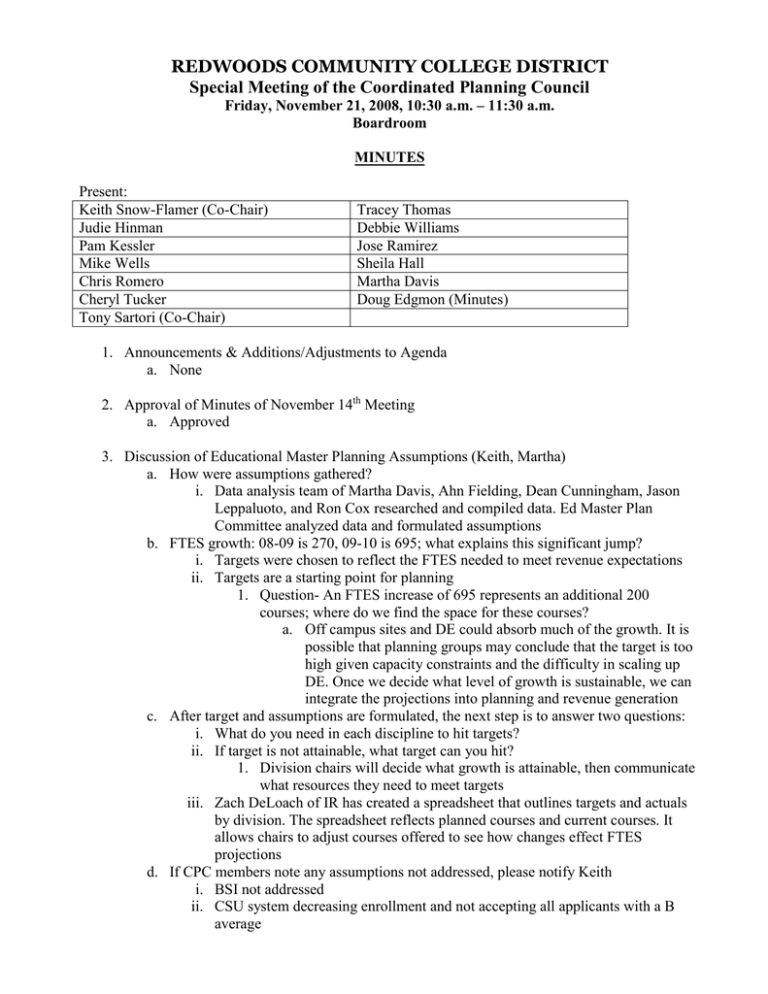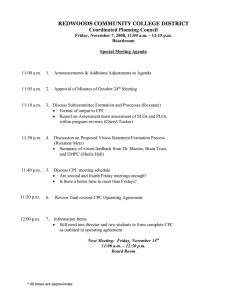REDWOODS COMMUNITY COLLEGE DISTRICT Special Meeting of the Coordinated Planning Council
advertisement

REDWOODS COMMUNITY COLLEGE DISTRICT Special Meeting of the Coordinated Planning Council Friday, November 21, 2008, 10:30 a.m. – 11:30 a.m. Boardroom MINUTES Present: Keith Snow-Flamer (Co-Chair) Judie Hinman Pam Kessler Mike Wells Chris Romero Cheryl Tucker Tony Sartori (Co-Chair) Tracey Thomas Debbie Williams Jose Ramirez Sheila Hall Martha Davis Doug Edgmon (Minutes) 1. Announcements & Additions/Adjustments to Agenda a. None 2. Approval of Minutes of November 14th Meeting a. Approved 3. Discussion of Educational Master Planning Assumptions (Keith, Martha) a. How were assumptions gathered? i. Data analysis team of Martha Davis, Ahn Fielding, Dean Cunningham, Jason Leppaluoto, and Ron Cox researched and compiled data. Ed Master Plan Committee analyzed data and formulated assumptions b. FTES growth: 08-09 is 270, 09-10 is 695; what explains this significant jump? i. Targets were chosen to reflect the FTES needed to meet revenue expectations ii. Targets are a starting point for planning 1. Question- An FTES increase of 695 represents an additional 200 courses; where do we find the space for these courses? a. Off campus sites and DE could absorb much of the growth. It is possible that planning groups may conclude that the target is too high given capacity constraints and the difficulty in scaling up DE. Once we decide what level of growth is sustainable, we can integrate the projections into planning and revenue generation c. After target and assumptions are formulated, the next step is to answer two questions: i. What do you need in each discipline to hit targets? ii. If target is not attainable, what target can you hit? 1. Division chairs will decide what growth is attainable, then communicate what resources they need to meet targets iii. Zach DeLoach of IR has created a spreadsheet that outlines targets and actuals by division. The spreadsheet reflects planned courses and current courses. It allows chairs to adjust courses offered to see how changes effect FTES projections d. If CPC members note any assumptions not addressed, please notify Keith i. BSI not addressed ii. CSU system decreasing enrollment and not accepting all applicants with a B average iii. Population of adults over 50 is an opportunity identified as well as the possibility of increasing the average number of units students are carrying. Increasing the number of students over 50 may have a negative correlation with the average number of units per student iv. EOPS serves a substantial portion of CR’s population, are they addressed in the planning assumptions? 1. Basic skills population probably represents most EOPS students v. Federal funding for students may decrease and student loans qualifications are becoming more stringent. These should be addressed in the assumptions. 4. Discuss Action Planning Guidelines and Timetable (Cheryl) a. Action planning committee has sent guidelines to action plan authors explaining the Action Plan Update requirements. They are due December 1st and will be presented to the CPC December 12th b. Call for action plan proposals: The sooner we receive action plan proposals , the more effective we can be in integrating them into the budget i. CPC will send out a call for proposals at the end of Fall 08 semester ii. Call for action plans will go out Monday, Dec 1st c. Action Plan Training will take place Jan 16, 2009 (flex day) d. Last Spring, CPC had a lot of suggestions for revisions to the Action Plan proposal form. Guidelines and proposal form need updating. i. Planning Support Team will collaborate with Action Plan subcommittee to update guidelines and proposal form ii. CPC approves revisions to guidelines and proposal form e. Do we want to increase the dollar amount maximum for individual Action Plan proposals? i. CPC will increase max Action Plan request to $25,000 ii. Proposals should stage resource requests to allow sub-pieces of requests to possibly be funded, if the whole project is not approved iii. Authors will have to report back to CPC and tie requests much more closely to strategic goals and program review than they have in the past. Authors must report how they are progressing towards meeting goals iv. Cheryl can report to the CPC the revisions to guidelines and proposal form at the Dec 12th meeting 5. Identify Baseline Data for Strategic Plan (Martha) a. Remove from agenda and discuss in spring semester? b. May be helpful to identify baseline data in order measure progress towards strategic goals c. Problem is that data is not meaningful without context. We would like to spend more time talking about KPI measurements to define context. We need to identify the meaning of the numbers. d. The answers to the questions are much more complex than what we thought when we first examined the strategic plan e. Measures must be broken down to make them more precise and meaningful to whatever group is using them. We need to define the indicators more precisely than we did before, agree on them, and move forward f. Division and program level indicators are important and useful, but so are college level indicators. We need to know the current data on the college as a whole so we can measure our progress as we move forward. How else do we determine if our integrated planning process is effective at a district level? g. We need to start with what we have while keeping in mind that we will probably make changes as we become more proficient at using data to track our progress h. The data may not convey much information now, but as we track the same measurements year after year a relationship will form i. We are judging the future on the baseline, so we need to make sure the baseline data is accurate j. Next steps: Can we call on Martha to examine the strategic plan and present to CPC how we should measure the plan. If we have problems with how we are doing it now, we should come up with an alternative instead of dwelling on what we don’t like about our current methods. Lets come up with an alternative we can agree upon this year and use three or four years down the road. 6. CPC Subcommittee formation and process a. Group one summaries from CPC subcommittees have been posted on the WIKI; group two program reviews are posted and ready for review by subcommittees b. CPC needs to discuss how the detailed findings of the subcommittees is presented to the CPC and the process for considering and incorporating that information into the master planning document Next Meeting: December 12th, 11:00 a.m.- Boardroom Minutes taken by Doug Edgmon @ 4148 or doug-edgmon@redwoods.edu

